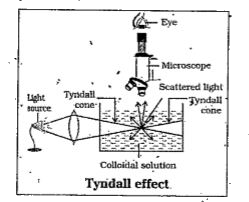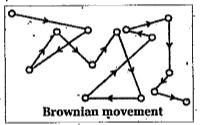Explain Tyndall effect and Brownian movement. Solution in Telugu
Tydall Effect : When a beam of light is passed through a colloidal solution the colloidal particles scatter the light in all directions. This scattering of light illuminates the path of beam in colloidal dispersion. This is known as tyndall effect. The bright cone of the light is called Tyndall cone.

Tyndall effect is observed only when the following two conditions are satisfied.
i) The diameter of the colloidal particle should not be much smaller than the wave length of the light used.
ii) The refractive indices of the dispersed phase and the dispersion medium should differ greatly in magnitude.
Brownian movement : The colloidal particles are in continuous zig-zag motion due to bombardment of the molecules of the dispersion medium on colloidal particles.
The motion of colloidal particle is independent of the nature of the colloid but depends on the size of the particles and viscosity of the solution.

Topper's Solved these Questions
- MODEL PAPER 5BOOK - VGS PUBLICATION-BRILLIANTCHAPTER - MODEL PAPER 5EXERCISE - SECTION - C
8 Videos
- MODEL PAPER 5BOOK - VGS PUBLICATION-BRILLIANTCHAPTER - MODEL PAPER 5EXERCISE - SECTION - C
8 Videos
- MODEL PAPER 4BOOK - VGS PUBLICATION-BRILLIANTCHAPTER - MODEL PAPER 4EXERCISE - SECTION-C
11 Videos
- MODEL PAPER 6BOOK - VGS PUBLICATION-BRILLIANTCHAPTER - MODEL PAPER 6EXERCISE - SECTION - C
6 Videos
Similar Questions
Give a detailed account of the Collision theory of reaction rates of biomolecular reaction.
View SolutionGive a detailed account of the Collision theory of reaction rates of biomolecular reaction.
View SolutionWhat are galvanic cells ? Explain the woriking of a galvanic cell with a neat sketch taking Denicell cell as example.
View SolutionHow is nitric acid manufactured by Ostwald's process ?
View SolutionExplain the terms 'Brownian movement' and 'peptization'.
View Solutionनिम्नलिखित की व्याख्या कीजिए-
टिण्डल प्रभाव
View Solutionउदाहरण द्वारा समझाइए -
(i) स्व उत्प्रेरण या एन्जाइम उत्प्रेरण
(ii ) टिंडल प्रभाव या ब्राउनियन गति ।
View SolutionWhat is tyndall effect ? Explain.
View SolutionWhat is Tyndall effect? Explain.
View SolutionWhich one of the following does not show Tyndall effect and Brownian movement?
View SolutionExplain Tyndall effect and Brownian movement with suitable diagram.
View SolutionWrite notes on
i. Brownian movement
ii. Tyndall effect
iii. Helmholtz double layer
View SolutionExplain Tyndall effect and Brownian movement .
View SolutionWhat are (i) Brownian movement and (ii) Tyndall effect ? Draw diagrams to illustrate them.
View SolutionExplain Tyndall effect and Brownian movement.
View SolutionExplain Brownian movement.
View Solution